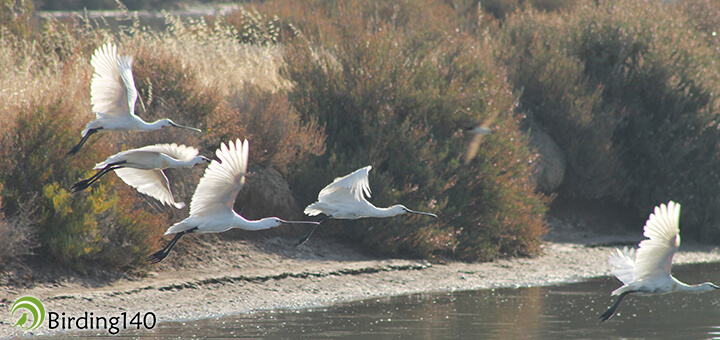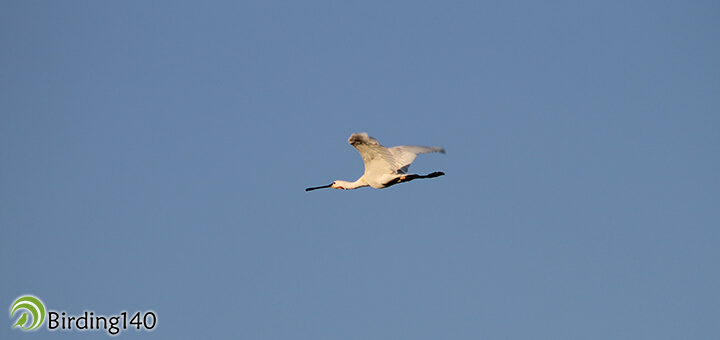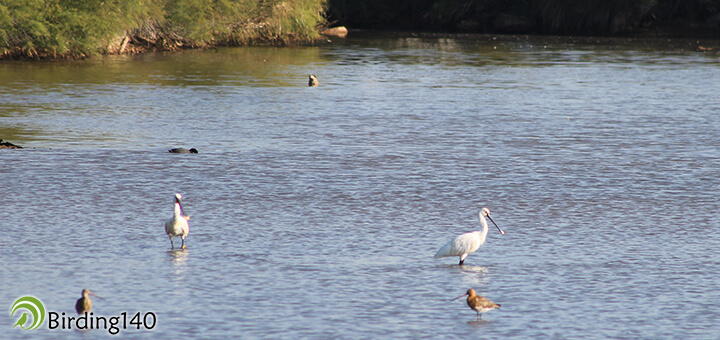The marsh wakes up with the usual yelling and flapping of the morning. The sunbeams begin to warm the cork oak 108, bringing life back to the settlement it has been hosting since the seventeenth century. A vehicle approaches from the Palace of Doñana and stops a few metres away. A human shadow comes out and climbs through the web of irons from the tower of the improvised hide in order to reach the highest branches.
His idea is to stay there until 2 pm, as every morning, enjoying his family of spoonbills. The doctor has recommended him to slow down his professional activity and the study of these white ladies makes him forget for a while the feverish activity he is subject to.
When he took out his binoculars through the loophole, the colony greeted him with snorts and semi-open wings. The trumpeting and nasal sounds did the rest to betray his presence. These signs made him step back and tighten the canvas on the other side against some of the nests, which got a very effective result in the form of pecks.
Little by little, the colony accepted him as a voyeur to show him all its structure and secrets. The hours in the casemate allowed him to make a study of the colour changeability of these bird’s curious beak. After hours of observation, notes and drawings, he came to the conclusion that the world of spoonbills is divided in hunting grounds (marshy pikes), places to rest (where they bathe and drink), places to collect twigs for the nests, and the colony.
As in a residential block, cohabitation prevailed in the cork oak. Looking through his binoculars, the first thing he could see were the highest branches. Among them were the nests occupied by immature males which were learning what it was like to be a spoonbill. They were like gang members altering the calm of the colony. They spent much of the day stealing sticks from other birds’ nests, fighting each other or trying to get a female. What differentiates these individuals from adults is their rosy beak and the tip of their black wings.
Below, in the middle branches, were the breeding nests, occupied by adult couples. They can be distinguished by the feathers with yellowish flashes in their abundant crest and in the panel on the base of their necks. This feature stands out the most during the nesting period, from April to July. During the first days, the couple doesn’t leave the nest even if it rains. They turn their heads, put their beak between their back feathers and stoically endure the water.
When he turned his binoculars, he could see how the theft of material is not only typical of sub-adults. A couple was taking advantage of a sloppy neighbour in order to redecorate their nest with its twigs. Two nests further, another couple was mutually caressing with the beak on the base of the neck. After the cuddling, the male went round the nest a few times and patted the female. It all ended with the mating and a consented display of crests. He had just witnessed the complete nuptial ceremony on site.
Meanwhile, in a closer nest, the male arrived to substitute the female. The couple burst in yells and a continuous display of crests to make the change of guard. When prospecting all the nests, he could see that the chicks, little balls of white down feather, first showed a short beak which became yellowish orange as they were growing. Other chicks, more developed, balanced at the end of a branch waiting for the calories that their parents would bring from the marshland. With all the swinging, one of them fell off to the nest below. The neighbours punished him with pecks on the legs and close to the eyes, until it could return to its home.
After looking around the cork oak, he could see several specimens with half their beak immersed a few metres away. They were moving forward, wading the water with half their legs immersed and moving their beaks from left to right. Their swinging might have scared a prey, because one of the spoonbills quickly immersed its whole beak and followed it swiftly. With each twist of the prey, the bird turned to the other side until it managed to catch the fish.
He was surprised by how it had detected its price in such muddy waters. But apparently, its unmistakable flat beak hides some nerve cells that detect any vibration of the water produced by movement. Several specimens flew over the scene soaring in a row with the wings and neck spread, proudly showing the beaks that give them their name. It was more than enough to fill the notepad and the film of the camera. He went slowly down the iron structure and arrived to the car to head towards the palace.
During that month of May, in 1958, the notes, drawings and photographs were filling several folders. The study summarised above was left uncomplete because the doctor José Antonio Valverde, founder of the Biological Station of Doñana and the then future National Park, had to go back to work. Years later, the Belgian biologist Claudine de le Court resumed it with the study of individuals in the Odiel Marshes in Huelva, a project that she still carries out today.
An experience similar to Valverde’s, relatively speaking, can be enjoyed nowadays from the vitrines of the visitor centre that carries his name in the north of the National Park. This point of information is located in Aznalcázar (Seville), and has crystal walls that turn it into a privileged observatory for the aviaries that are found in the cork oaks.
From a distance, we can confuse them with egrets or herons. But if we take a closer look, they can be distinguished by their characteristic flat beak, which they usually lean when we face them. In Europe, this species is estimated in 6,000 to 10,000 couples divided in two populations: one in Central Europe and one in the eastern Atlantic (Netherlands, Denmark, France, Spain and Portugal).
They prefer coastal waters and they breed in colonies, frequently shared with egrets and herons, in pines and cork oaks of great size. Although they sometimes choose the ground or small bushes in order to lay their eggs in inaccessible areas or with little human pressure.
In Spain, the breeding specimens are mostly located in Doñana National Park, in the Natural Area of the Odiel Marshes and in the Bay of Cádiz. These colonies have been showing a clear positive trend in the last years, except during dry seasons, due to the obvious lack of food.
Their main wintering area is located in Mauritania and Senegal. But there is an important contingent, coming mostly from Holland, which spends the winter in Spain as an alternative to the long trip to Africa. Although, to a lesser extent, specimens from the French and German colonies also arrive to the Iberian Peninsula. The most crowded wintering occurs in O Grove, Santoña, the Ebro Delta, the Guadalquivir and Odiel Marshes and the Bay of Cádiz, as well as in small areas in Extremadura. Needless to say, especially in winters with heavy rainfalls, spoonbills prefer Andalusian destinations.
In Spain there are two associations responsible for the collection of data regarding these migratory flows. In the north, GRUSEC is the monitoring group of this species in Santander, and in the south, the Natural History Society of Cádiz (Sociedad Gaditana de Historia Natural), with their Limes Platea project, monitors with patrols the movements of the spoonbills in Cádiz. In summer of 2012, this entity discovered the migratory corridor Playa de la Barrosa-Cabo Roche, where more than 15,000 birds in transit have been recorded. This means more than 90% of the Eastern European population of the species.
In Holland, the Nederlandse Ornitologische Unie (NOU) and Dutch Birding (DBA) collect these data. Any of these four entities will gladly accept the species sightings we send them, and they also collect the readings of their rings to carry out studies about their travels.
The colonies in the north of Europe are very sensitive to the alterations made by humans during the breeding season, and the biggest threats come from the draining of wetlands and the pollution caused by pesticides.
In Spain, the colonies of Doñana, Bay of Cádiz and Isla Cristina are suffering due to human disturbances and to the attacks of wild dogs to the nests located on the ground. Meanwhile, in the Odiel Marshes the spring tides cause the biggest loss of broods and chicks. Although we should mention the conservation plans carried out in the Odiel Marshes and Doñana. From our blog we ask for more protection and surveillance for the colonies, as well as a study about the impact on each of them. We also ask for the collaboration of the owners of the feeding areas. It is also beneficial to have measures to set and settle the colonies of Extremadura and Cantabria. This is the only way to keep enjoying this beauty of singular beak and its habits, as we described in the first lines of this text.














